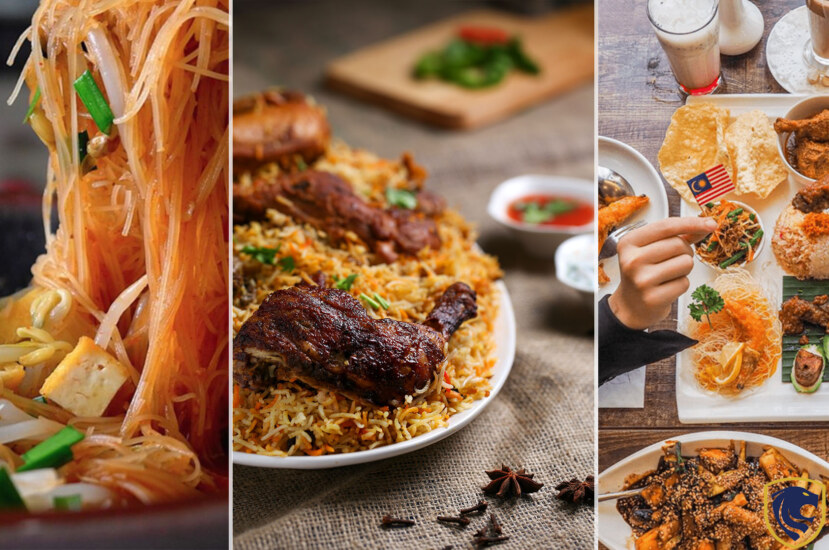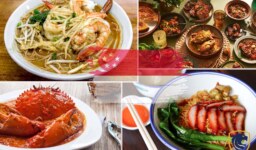Discover Malaysian cuisine‘s complex tapestry of flavors, a dynamic blend of Malay, Chinese, Indian, and indigenous influences. Malaysia’s culinary sector provides a stunning mix of traditional cuisines that represent its broad cultural past, from lively street vendors to elegant restaurants. We go into the heart of Malaysian food on this gastronomic trip to discover the essence of meals that have become cultural icons. Here, every meal is a celebration of tradition and a revelation of the country’s culture.
Nasi Lemak
Nasi Lemak, is a popular Malaysian meal. It is a fragrant and savory rice dish that embodies the country’s culinary history. This meal exemplifies Malaysia’s cultural variety, combining Malay, Chinese, Indian, and indigenous flavors into a harmonious and delightful concoction. The rice at its Centre is cooked with coconut milk and pandan leaves, giving it a rich and fragrant flavor that sets it distinct. Also, the rice develops a somewhat creamy texture and emits an alluring scent with each bite. A variety of delectable side dishes accompany the rice, elevating Nasi Lemak to a complete and delicious dinner. The sambal, a hot chili sauce with a fierce bite, serves as the dish’s anchor. Also, a hard-boiled or fried egg sits beside it, giving a dash of protein to the dish.

Nasi Lemak ;Best Traditional Dishes From Malaysian Cuisine
The meal also includes crunchy peanuts and ikan bilis (anchovies), which provide textural contrast and a pleasant salty flavor. Moreover, fresh cucumber slices give a refreshing counterpoint to the spiciness of the sambal, while rendang, fried chicken, or sambal squid add protein to the dish. Nasi Lemak’s adaptability makes it an excellent choice for breakfast, lunch, or supper. It’s widely consumed throughout Malaysia, from street vendors to elite restaurants, demonstrating its global appeal. The meal embodies the essence of Malaysian culture and togetherness, embodying the nation’s variety.
Nasi Lemak is more than simply a meal in Malaysia; it’s a cultural symbol that brings people together with its wonderful combination of flavors and textures. Whether you’re a native or a visitor, a dish of Nasi Lemak is a must-try experience that captures the heart and spirit of Malaysian cuisine.
Roti Canai
Roti Canai, a Malaysian culinary staple, is a delightful flatbread that epitomizes the country’s culinary talent. This renowned meal has simple roots. But it has a wonderful richness of flavor that has won the hearts of both residents and visitors. The secret to Roti Canai is in the preparation. The dough is stretched, folded, and fried with finesse until it acquires a delicate crispness on the exterior. But it remains soft and airy on the inside. As a result, the end product is a flaky, layered beauty that’s a pleasure to cut into. Roti Canai is traditionally eaten with a side of dhal (lentil stew) or a spicy curry, although it also comes in sweet versions. A sprinkling of sugar or condensed milk may turn this savoury bread into a delectable treat. It would be great for those with a sweet craving.

Roti Canai
The “tarik” method – the theatrical skill of tugging and turning the dough to create its unique layers – is part of the Roti Canai experience. This astounding demonstration of ability is not just a culinary performance. But also a monument to the cooks who have perfected this profession. Roti Canai is more than simply a food; it’s a community experience, whether savored at crowded street booths or cozy neighborhood cafes. Malaysians from all walks of life congregate to celebrate this event.
The popularity of Roti Canai has spread beyond Malaysian boundaries, becoming a must-try dish for visitors discovering the country’s gastronomic tapestry. Its simplicity, paired with its rich flavor and cultural importance, exemplifies Malaysian food at its best.
Laksa
Laksa is a tantalizing noodle dish with robust and fragrant flavors that is a highlight in Malaysian cuisine. This culinary masterpiece exemplifies Malaysia’s many cultural influences. Laksa is distinguished by a delicious and aromatic broth. Two separate variants, Penang and Sarawak, demonstrate the dish’s versatility. Penang Laksa features a sour fish broth, whilst Sarawak Laksa has a spicy coconut milk base. Both variants share a symphony of flavors created by a harmonizing combination of spices. Moreover, the toppings are the heart of laksa. Succulent prawns, soft chicken pieces, tofu puffs, and hard-boiled egg interact with rice or vermicelli noodles, creating a delectable blend of textures and flavors in every spoonful.

Laksa ;Best Traditional Dishes From Malaysian Cuisine
The rich spice combination distinguishes Laksa. Lemongrass, galangal, chili, and different herbs combine to produce a diverse character that is both stimulating and gratifying. Laksa is a brilliant kaleidoscope of colors that reflects Malaysia’s cosmopolitan identity. It is served with a liberal sprinkle of fresh cilantro, chopped red onions, and a squeeze of lime. Laksa’s appeal has crossed boundaries, grabbing the taste buds and hearts of food fans worldwide, whether served at hawker stalls, family-run eateries, or even sophisticated establishments. Each bowl of Laksa has a slice of Malaysia’s history and variety, a real reflection of a country that thrives on its ability to merge cultures and flavors into something truly amazing.
Char Kway Teow
Char Kway Teow, a beloved Malaysian meal, is a wok-fried noodle dish with smokey flavors and savory richness that tantalizes taste receptors. This meal takes you on a gourmet tour of Malaysia’s street food culture. The meal has flat rice noodles that have been perfectly stir-fried with prawns, Chinese sausage, eggs and bean sprouts. Moreover, the ingredients dance in unison on the scorching surface of the wok, absorbing the essence of soy sauce and chili for a rush of umami and spice. The charm of Char Kway Teow resides in its simplicity. The combination of textures – chewy noodles, juicy prawns, and crunchy bean sprouts – results in a delightful mouthfeel that leaves you wanting more.

Char Kway Teow
A sprinkle of chili paste adds a delicious kick to the entire flavor profile. The last flourish of chopped chives gives a welcome contrast to the richness of the meal. Char Kway Teow, which originated as a simple street meal, captures the spirit of Malaysia’s unique culinary history. It’s a tribute to the hawker sellers’ talent in using their woks to produce this renowned meal. Char Kway Teow, which can be found at hawker canters and food stalls around the country, is a comfort dish that bridges the gap between tradition and modernity. It satisfies both residents and curious visitors looking for a genuine Malaysian experience.
Hainanese Chicken Rice
Hainanese Chicken Rice, a Malaysian favorite, is a dish that is simple yet exceptional. This culinary jewel exemplifies the delicate art of balancing as well as the impact of Chinese flavors on Malaysian cuisine. The luscious poached chicken at its heart is delicate and flavorful. The meat is painstakingly prepared. As a result, it has a velvety texture that attests to the dish’s culinary skill. Flavorful rice is served alongside the chicken, which has been simmered in chicken broth to extract its essence. As a result, each mouthful is elevated by a gently fragrant basis. However, it’s the trio of sauces that really elevates Hainanese Chicken Rice. A spicy chili sauce, a zesty ginger paste, and a soy-based dip add layers of flavor and complexity to the meal.

Hainanese Chicken Rice
The attraction of Hainanese Chicken Rice resides in its comfortable simplicity. The interaction of textures and flavors creates a pleasurable experience that crosses cultural barriers. This meal draws people together, connecting them in the satisfaction of savoring a timeless comfort food that embodies Malaysia’s mixed character. It can be found in both hawker stalls and restaurants. Every bite of Hainanese Chicken Rice reveals Malaysia’s ability to combine tradition with innovation, resulting in a dish that reflects the country’s culinary growth as well as its power to captivate hearts and palates throughout the world.


